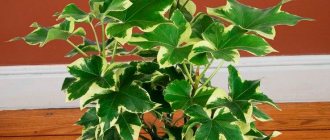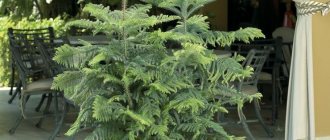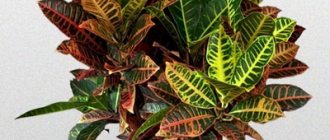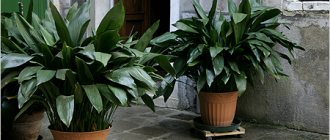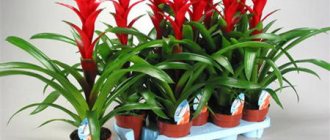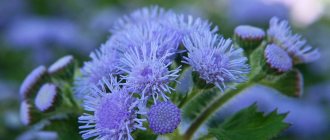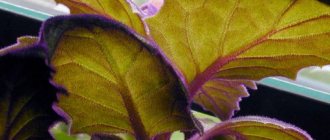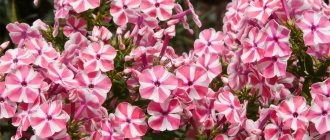Heliconia is recognized as a prominent representative of the tropics, which can be grown at home. This curiosity of the plant world does not often end up in the collection of flower growers, but the fabulous appearance of the flower makes even beginners pay attention to it.
Related posts Hemanthus Zebrina Aeschynanthus Brachychiton
With bright light and sufficient humidity, the crop can bloom all year round with multi-tiered scarlet ears. No less decorative are the wide leaves of the plant, similar to those of bananas.
Botanical description
According to Greek mythology, the name of the genus is associated with Mount Helikon, where charming muses lived near sacred springs. Until the beginning of the twentieth century, Heliconia was part of the Banana family. But the similarity was only external. Further, at the insistence of the Japanese scientist Nakai, the culture was allocated in 2003 to a separate family of Heliconiaceae, which is included in the order Zingiberaceae.
In its natural environment, it is distributed in the tropical forests of Central and South America with a humid climate, where it grows on mountain slopes, in forests, on the sea coast, near rivers - that is, in all damp places with good drainage. The genus includes about 2,500 species of Heliconia, but only about 200 species have been described in detail by botanists.
Heliconia is a rhizomatous herbaceous perennial and develops from the underground part. Some species are cultivated for home cultivation due to the variegated color of the inflorescences and the different sizes and shapes of the leaves, similar to those of a banana, but unlike it, the arrangement of the leaf blades is double-rowed.
The location of the rhizome is horizontal, from which a pseudostem with many vaginal leaves grows. The plant can reach a height of 3 to 6 or more meters and about 1-2 meters in width.
A characteristic feature of the culture is the bright inflorescence, which is mostly formed on the terminal part of the erect shoot. And only some varieties form inflorescences in basal shoots without leaves. They can remain on the bush for several days and even months, then die off along with the shoot. The crop blooms the next year after planting.
Local residents compare the bizarre shape of the leaves to a crab claw, and the brightly colored bracts in yellow-orange, pink and scarlet tones to a parrot's beak. Hence the name of the flower - parrot. The border on the edges of the bracts in a yellow or green hue gives greater expressiveness to the inflorescences with a glossy shine and elasticity due to a waxy coating.
Due to the similarity of the plant with Strelitzia, Heliconia is called false bird of paradise or false Strelitzia. In some species, the structure of the inflorescences is strikingly similar to an intricately shaped shoe. The flowers themselves are inconspicuous and seem to be aware of this shortcoming, hiding under the covering leaves. After flowering is completed, deep blue seed fruits are formed.
The desire to grow heliconia at home does not always coincide with the owners’ space capabilities. It should be taken into account that heliconia has considerable dimensions for growing indoors, from 0.6 to 3 meters in height and 0.5-2.0 meters in width.
Reproduction codonants
For an elegant indoor vine, it is better to choose vegetative propagation methods:
- Separation of adult bushes, which is carried out during transplantation, carefully separating 2-5 shoots from the main clump along with a piece of rhizome and planting them as a young plant in a new container. Before rooting, plants need vigilant, careful care, warmth and brighter lighting;
- Cuttings: Stem cuttings can be taken from codonanta shoots by cutting out non-lignified sections about 10 cm long with several pairs of leaves. After removing the lower leaves and shortening the upper ones, the cuttings can be rooted in water or in a substrate under a hood, and within a month the plant will begin to develop. Codonant plants obtained from cuttings are planted not individually, but up to 3 plants in one pot.
You can also get new plants from seeds that are sown in a high-quality substrate under film or glass. As the plants grow, you need to pick 2-3 plants in containers, gradually growing them and providing the young crops with regular care.
Bihai
The herbaceous perennial is characterized by a large-sized appearance with leaves more than 1.2 meters long and 35 to 45 cm wide. Large inflorescences exceeding 0.5 meters contain many flowers, light yellow or green in color, growing from bright red sheaths.
Along the edges of the colorful bracts there is a noticeable yellow border. You can see what the Heliconia Bihai variety looks like in the photo below:
Heliconia Bihai
Bicolor
The spectacular perennial has a more modest height and does not exceed one meter. The elongated half-meter leaves are sword-shaped and relatively narrow - only 10 cm. The base of the leaf blade has a wedge-shaped configuration. Inside the red bracts, 2 rows of white flowers are formed, which enhances the decorative effect of the heliconia.
In the photo below is the Heliconia Bicolor variety:
Heliconia Bicolor
Metal
The culture is notable for its oval-shaped leaves of intense herbal color, slightly oblong at the ends, up to 300 mm long. The back side of the foliage is purple-red. The surface of the leaf blades has a metallic sheen, hence the name of the plant. A white vein stands out in the middle of the leaf. Heliconia can grow up to two meters in height. Red buds are formed inside the green bracts, which are sometimes pink in color.
The photo below shows Heliconia Metallic:
Heliconia Metal
Rostral
With proper care, the rostral blooms all year round. The foliage is associated with banana leaves, they are so similar in appearance. Produces a flat, drooping, bright red inflorescence with yellow-green tips. One peduncle can form up to 35 bracts of a classic shape.
Cut heliconia stems in water without immersing the inflorescences remain viable for up to three days. It is necessary to change the water every other day and add flower food to it.
Heliconia Rostral
Eucodonia Adele and other varieties
There are only two known species in the genus Eucodonia. Plants differ from each other not only in the decorativeness of their flowers, but also in the appearance of their leaf blades.
In home floriculture, many original hybrids and natural varieties are used.
The most popular species is Eucodonia Andrieuxii or Eucodonia Andrex.
It is a perennial with decorative leaves. Most varieties of the variety have this property.
The leaf blades are a rich olive-brown shade. The edge of the plate is serrated. The surface is covered with small hairs.
The lower part is always brighter or just a different shade. The veins are pubescent with small pink or reddish hairs. The flowers are white or lavender.
The most famous varieties that can be easily grown at home:
Woolly Morion is a very ornamental plant that looks attractive even without flowers.
Its leaf blades are heavily pubescent with reddish hairs. The reverse side is pink with ash shades.
During the period of active flowering, the perennial produces several long peduncles with single lavender-colored buds. The corolla is medium in size.
Tintocoma is a variety with almost blue leaves and medium-sized bell-shaped flowers.
The leaf blades are covered with pink hairs.
Adele is one of the most famous varieties.
A perennial with large leaf blades and deep blue bell-shaped flowers.
Gray Stone - got its name due to the rosette of dark green leaves with a gray coating.
The second known species is Eucodonia whorled or eucodomiz Verticillata .
The leaves of this perennial variety are collected in a dense green rosette. Plates pubescent with serrated or jagged edges.
The flower of the culture is lilac or pink, less often purple. There are also varieties with white flowers and a snow-white throat.
The most famous varieties in home floriculture are:
Noomi is an ornamental deciduous crop with pubescent leaf blades.
The lower part of the leaf is lighter. The flowers are pink or bright purple.
Ethrenberg – blooms with lilac flowers.
The variety is decorative even during the dormant period, as it has slightly purple leaves, which are completely bright on the reverse side.
Parrot
The peculiarity of the Parrot variety is its bright bracts in all shades of orange and red. It is noteworthy that on the same bush they can be unevenly colored. The bract itself is shaped like a cockatoo's crest. The petals of small whitish flowers have a black color at the edges. The spiral-shaped inflorescence grows vertically. A voluminous bush with many lanceolate leaves of a juicy green color reaches a height of 2 meters.
Heliconia parrot
Straight
A medium-sized variety of compact shape and size from 0.3 to 1.5 meters produces an inflorescence that resembles a bird spreading its wings in flight. Bright red bracts of a sharp oblong shape are located perpendicular to the stem at an angle of almost 90 degrees. Based on the Direct variety, varieties with sunny yellow and coral bracts were selected.
Heliconia Direct
Description, origin
The Codonanta genus, although it belongs to the Gesneriaceae family, is a completely atypical representative of it. All plants of the genus are epiphytic subshrubs with thin creeping shoots, which are most often used in indoor culture as ampelous ones.
Although the codonanta is great at pruning, and nothing prevents you from forming a small bush out of it if desired. True, the shoots grow and branch quite quickly, so soon the plant will need supports. Codonanta is native to the forests of South America.
The name of the genus literally means “bell-shaped flower” in Greek.
The shoots of codonanta are very thin and can grow up to 1.5 meters in length. The leaves are dense, leathery, of various shapes, growing on the shoots in pairs, but not very densely. As a result, a cascade of numerous shoots creates an airy, translucent crown.
The flowers, justifying the name of the genus, are shaped like small wax bells of white, yellow or cream color. They appear in the axils of codonanta leaves from June to September. Many species are famous for the scent of their flowers. In favorable conditions, bright shiny berries will soon form in place of the flowers, which add additional decorativeness to the codonante. Most often, in order for berries to appear, it is necessary to carry out artificial pollination indoors.
Indian
The peculiarity of the Indian variety is the burgundy-bronze color of dense paddle-shaped leaves located on long thin petioles. Variegated species with veining on the foliage in white, yellowish and pink tones. Falling inflorescences of rich lime color.
According to the teachings of Feng Shui, heliconia should not be placed near the sleeping place or in the children's room, since during sleep it absorbs the vital energy of the household.
Heliconia indica
Reproduction
Root suckers
Performed in stages:
The root shoot is separated from the mother plant, always leaving a fragment of the rhizome. Use a well-developed root.- The pots are filled with permeable compost. Separated offspring are planted in it.
- The soil should be slightly moist, so sparing watering is practiced.
- When the indoor air is dry, cover the pots with a plastic cap with holes so that it does not touch the leaves. In this case, watering is excluded, since greenhouse conditions are created inside the cap.
- The pots are placed in partial shade in a warm place with a humidity level of at least 70%.
New growths from root shoots appear after three weeks, then the need for a cap disappears. Next, care according to the usual rules for heliconia.
Seeds
Growing heliconia from seeds is not difficult:
Seeds are pre-soaked in water for 3-4 days
It is better to keep the container on a heated mat at temperatures up to 50 degrees. If you don't have one, a thermos will do.
At this time, the box is filled with peat and sand.
The swollen seeds are laid out on the surface of the soil, deepening no more than 2 cm.
For the greenhouse effect, which promotes rapid seed germination, cover the crops with film.
Water with a meager volume of water and ventilate.
The appearance of the first shoots is expected no earlier than 4 months; for some varieties, seed germination takes up to a year. The waiting period can be shortened by pre-cutting the seed. Sandpaper is suitable for these purposes.
Dividing the bush
To propagate heliconia by dividing the bush, an adult specimen must have a well-developed root system. The bush is carefully divided into several parts and planted in separate pots. This operation is performed in the spring.
Place in a dark room with a temperature of 22 to 27 degrees Celsius and maintain high humidity at 80%. Sprouts appear after 3 weeks, after which they are provided with the usual conditions of detention.
Eucodonia photo
Eucodonia
© liangjinjian
Eucodonia requires good lighting, and prefers bright, diffused light, but it is better to shade it from direct sunlight. Increased air humidity is necessary; in summer it is better to place a pot of eucodonia on a tray with wet pebbles. The plant is thermophilic; during the period of active growth it requires a temperature of about 23°C.
Eucodonia is watered regularly with warm (slightly above room temperature) settled water and during the growth period it is fed once a month with complete mineral fertilizer for ornamental flowering plants. After flowering, watering is gradually reduced to 1 - 2 times a month, dried leaves are cut 1 cm above the soil surface. Rhizomes are removed from the ground and stored in sand or peat at a temperature of 10 – 12°C. In spring they are placed in fresh soil. It is better to prepare the substrate for planting from leaf and greenhouse soil and crushed moss in a ratio of 4:2:1.
Eucodonia
© Manuela Olivares
Eucodonia reproduces by dividing the rhizome, which is cut with a sharp knife into several parts, each of which must have a bud. The sections are sprinkled with crushed charcoal. Reproduction is possible by seeds, apical and leaf cuttings.
Young shoots and flowers of eucodonia are often attacked by aphids. To get rid of the pest, you need to spray the plant with Fufanon or Actellik.
Diseases and pests
Errors in care lead to deterioration in the appearance of heliconia and affect the health of the plant. In addition, the bushes may be attacked by pests.
There is practically no information about possible diseases of heliconia, since the plant is characterized by strong immunity, more often it is rotting of the roots during overwatering, followed by the death of the flower.
Root rot is difficult to get rid of, and when detected, they immediately begin resuscitation measures - take out the bush, remove the rot, dry the roots, treat it with fungicides and replant it in new soil with good air permeability. But unfortunately, it is not always possible to achieve success.
Common problems when growing:
- yellowing of foliage is associated with a lack or excess of moisture, unsuitable soil for normal development;
- stretching of shoots occurs due to lack of lighting;
- leaf fall indicates that the plant is suffering from heat and dry air;
- yellowing at the ends of the leaves occurs from a lack of nutrition and an excess of calcium in the soil;
- Wrinkles appear on the surface of the leaves due to sudden changes in temperature or lack of microelements.
There are other problems and their resolution requires care adjustments.
Heliconia pays close attention to:
Spider mites can die if left in a humid environment for at least half an hour after bathing in the shower. You can try weekly exposure to an ultraviolet lamp for two minutes. From chemistry they use Fitoverm, Actellik, Nissoran, Massai. Sunmite is effective at all stages of tick development.
Mealybug. Its appearance resembles a pandemic; the pest spreads quickly and is difficult to get rid of. At the first appearance, the heliconia bush is sprayed with a solution of isopropyl alcohol, directing the stream to the place of accumulation of parasites. If the infection is severe, spraying with alcohol is repeated, and the soil is spilled with a weak solution of alcohol. More radical chemicals are Phosfamide, Rogor, Aktara, Teppeki.
Scale insects are an insidious scourge for heliconia and are always ready to spoil the decorative appearance of the plant. Since pests feed on plant sap, there is nothing better than spilling the soil with Aktara solution. Dilute strictly according to the instructions. The rhizomes begin to actively drink the solution, and the poison from it will immediately reach the pests. Aktara is ineffective against spider mites, but it deals with scale insects and false scale insects once or twice, that is, sometimes re-treatment is required.
Care
The temperature during the flowering period should not fall below 19 degrees. During dormancy, it is better to choose a cooler place for eucodonia with a temperature of about 10 degrees.
The lighting can be bright, but do not allow eucodonia to remain in direct sunlight for long periods of time.
Watering eucodonia depends on the stage of its development. From the moment you wake up, you need to water regularly and abundantly; during hibernation, do not water at all; between these periods, you need to reduce the amount of watering. Don't be afraid that the plant will dry out, that's how it should be. After this, it needs to be cut flush with the soil and hidden in the shade. You need to remember that when watering, water should not get on the leaves, this will have a bad effect on them.
To maintain moisture, eucodonia can be sprayed once a week. Moss spread around the pot will also help.
The soil should be chosen mixed; it should include sand, humus, soil, this will have a beneficial effect on the growth and development of the plant. You can consult a specialized store about which mixture is best to take.
